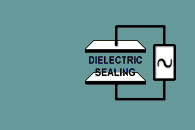General Considerations Sealing
Time Pressure To obtain high pressure and yet avoid the above disadvantages, the moving die is restrained in its motion by a “stop” on the press which is set to prevent the dies from closing completely when there is no material between them. This prevents the die from cutting completely through the material, and at the same time gives a seal of predetermined thickness. When a tear seal type of die is used, the stops are not set on the press, since a thinning of the tear seal area is desired. To insure a uniform seal, the proper pressure must be obtained at all points of the seal. To effect this, the dies are made or ground perfectly flat , and held parallel to each other in the press. The dies must also be rigidly constructed to prevent warping under pressure. PowerThe amount of power required for a good seal is directly proportional to the area of the seal. Moreover, thicker materials require less power than thinner materials. Our Sealing Area Chart shows the maximum area of seal obtainable with each unit. However, it must be kept in mind that these figures are for long thin seal, and for certain materials that are hard to seal. Adjusting Power, Time, and PressureWhen setting up a new sealing job the first test should be with minimum power, moderate time and around 80 psi pressure. If the seal is weak, power should be increased gradually. For greatest freedom from burning or arcing, the power should be kept as high as possible, consistent with good sealing. The dies must be held parallel to produce even pressure at all sections. If there is too much extrusion or if the seal is too thin, the press sealing stop should be used. To set the stop, place half the total thickness of the material to be sealed on the lower plate. Close the press and adjust the stop-nut finger tight. Then insert the full thickness of material in the press and make a seal. Check the result and lower or raise the stop as required. If the seal is weak at certain spots, the dies are not level. The leveling screws should be checked and adjusted. If these adjustments are still unsatisfactory, the die can be shimmed up at the problem areas or the die may have to be surface ground. After making a number of seals, the dies then warm up somewhat and the time and power may require re-adjustment after several hours of operation . To eliminate re-adjustment many machines are equipped with heated upper platens to pre-warm dies to operating temperatures. Use of heated platens is desirable when doing tear seal applications. Pre Seal time and a heated platen can
also change these factors
| |
DIELECTRIC SEALING - 1555 Indusrial Drive, Unit E, Itasca, IL 60143 (630) 834-2010 FAX (630) 834-4935 © 2010 Dielectric Sealing |


